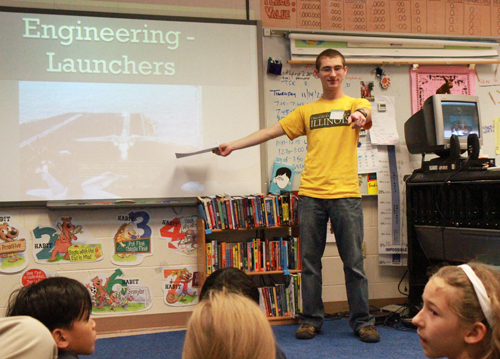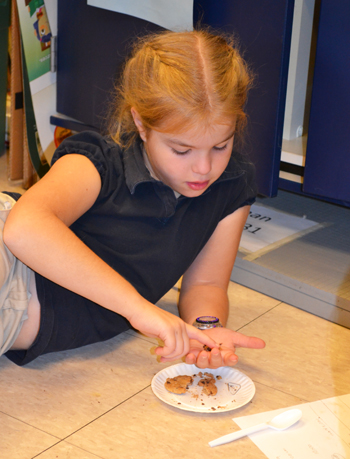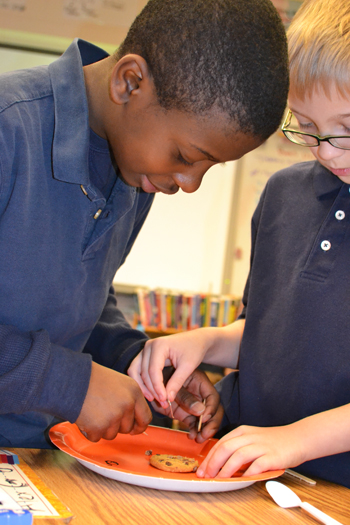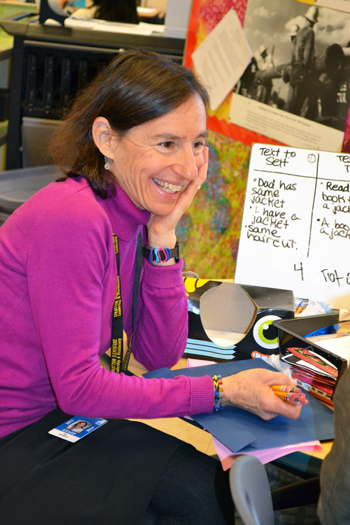MechSE's Dostart Hopes to Influence Local Youngsters to Choose Engineering

MechSE senior Nathan Dostart explains the Engineering Launchers hands-on project to Stratton fourth graders. (Photo courtesy of Joe Muskin, Education Coordinator of the Mechanical Science and Engineering Department.
December 9, 2013
Nathan Dostart, a senior in Mechanical Science and Engineering, spent some early mornings at Stratton School this fall, showing Zanne Newman's fourth graders "that engineering is really cool."
Poised to begin a career in Aerospace Engineering as soon as he graduates, Dostart wasn't exposed to engineering as a youngster. "Only Legos," he laments. It wasn't until the end of high school that he finally realized, "This is something I can go into in college." That was when he realized that he wanted to be an engineer.

Dostart (left) and a fourth grader discuss chocolate chip "mining" stratgies during the hands-on activity.
That's one of the reasons he started going into Stratton—so kids will add "engineer" to their list of possible careers.
"It's something I would like to help kids see at this young age. When kids are young, they're like," I want to be a firefighter; I want to be a doctor, or I want to be a pilot." But I want them to say, "I want to be an engineer. I think it would be really cool if at that age they already say, 'Oh, this is really cool. I'd like to do it.'"

Fourth-grader counts the number of chips she has been able to extract.
Dostart has a theory. He thinks when kids discover at an early age what they want to do in life, it gives them an edge—a head start.
"I feel like a lot of the people who end up doing the really great things in engineering and other STEM fields are people who said at a really young age, " Oh, I really like this; I want to do this." Then you have an advantage; you have all this passion; you learn things, and are more motivated. By the time you reach college, you are already going to know a lot more and be ahead of other people."
So he headed to Stratton to make sure the 4th grade students there have the kind of exposure to engineering he wishes he'd had at that age.
During his visits, he exposed them to a couple of types of engineering. For instance, on one visit, the youngsters designed and built engineering launchers, contraptions engineered to catapult a cotton ball as far as possible. On his second visit, Dostart gave students a chance to learn some mining principles via a potentially delicious, yet instructive, hands-on activity: "mining" chips from chocolate chip cookies.

Two Stratton fourth graders "mine" chocolate chips from cookies.
Armed with both a hard and a soft chocolate chip cookie, students were also equipped with several different tools and told to extract the chocolate chips from the cookies without breaking them.
During the inquiry-based learning activity, students made a number of valuable discoveries related to mining engineering, such as what tools, mining methods, and types of land work best in order to do the least amount of damage to the land ecologically. Cost vs. value economic factors also came into play during the lesson. Students' "companies" stood to make substantial financial profit (they earned a $1000 dollars for each chip they got out); however, each time they broke a cookie, they were fined.
Stratton teacher Zanne Newman, a participant in the EnLiST project for several years, is no stranger to the benefits of partnering with University folk. Her goal in having Dostart visit her classroom was "to inspire and excite students in our classrooms about engineering." Newman reports that it worked.
"The kids loved the two lessons that he taught," she shares, "and it has continued to be both an activity and a topic of discussion. We are still working on catapults to make them launch cotton balls farther."

Zanne Newman, Stratton School fourth grade teacher.
Does Newman see any future engineers in her class? "Yes, I see several. I am surprised how excited they are over a week later about re-working their catapults...(the lesson Nathan first taught)."
Dostart agrees, and reports noticing that some students had certain qualities, and could see them becoming engineers: "Kids who are really enthusiastic and give really good ideas or make really good connection that not everyone else will make."
In particular, he remembers one student who was talking about a vague concept called ramjets, a launch activity which converts from potential energy (energy waiting to be used, such as a stretched rubber band) to kinetic energy (something moving or flying through the air).
"This kid started talking about ramjets, and this is something that I only remember my sophomore year because it's a very complicated airbase concept. So it was interesting to hear someone who has already known that much. So I can see him there."
Story and photographs by Elizabeth Innes, Communications Specialist, I-STEM Education Initiative.
More: K-6 Outreach, MechSE, Stratton School, Student Spotlight, 2013

Nathan Dostart (second from left) and several Stratton 4th-graders test the the effectiveness of a launcher in catapulting a cotton ball. (Photo courtesy of Joe Muskin.)













.jpg)
















